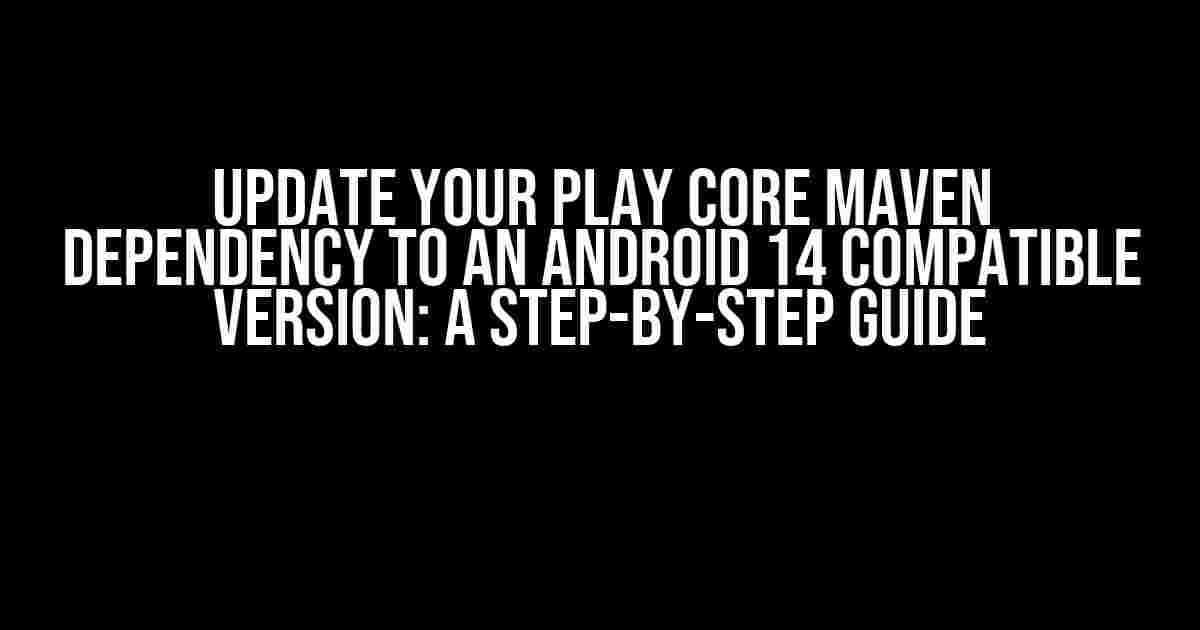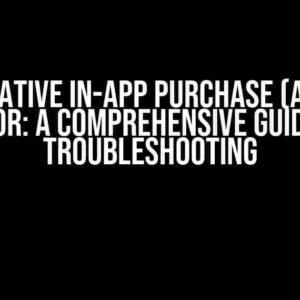Are you tired of dealing with compatibility issues in your Android app? Do you want to ensure that your app runs smoothly on the latest Android 14 devices? If so, you’re in the right place! In this article, we’ll take you through the process of updating your Play Core Maven dependency to an Android 14 compatible version.
Why Update Your Play Core Maven Dependency?
Before we dive into the nitty-gritty of updating your Play Core Maven dependency, let’s talk about why it’s essential to do so. With the release of Android 14, Google has introduced several changes that affect how apps interact with the Play Store. These changes include:
- New API levels and SDK versions that require updated dependencies
- Changes to the way apps handle in-app updates and reviews
- Enhanced security features that require compatible dependencies
If you don’t update your Play Core Maven dependency, you may encounter issues such as:
- Failed builds and crashes
- Inability to publish your app on the Play Store
- Poor app performance and reliability
Step 1: Check Your Current Play Core Maven Dependency
Before you start updating your Play Core Maven dependency, you need to check your current version. To do this:
- Open your Android project in Android Studio
- Navigate to the
build.gradlefile in your app module - Look for the
dependenciesblock and find the Play Core Maven dependency - Check the version number of the dependency
dependencies {
implementation 'com.google.android.play:core:1.8.1'
}
In this example, the current version of the Play Core Maven dependency is 1.8.1. If your version is older than 1.10.2, you need to update it to ensure Android 14 compatibility.
Step 2: Update Your Play Core Maven Dependency
Now that you’ve checked your current version, it’s time to update your Play Core Maven dependency. To do this:
- Open the
build.gradlefile in your app module - Update the version number of the Play Core Maven dependency to 1.10.2 or higher
- Sync your Gradle files
dependencies {
implementation 'com.google.android.play:core:1.10.2'
}
Make sure to update the version number to the latest compatible version. You can check the Play Core Library release notes for the latest version.
Step 3: Update Your App’s Target SDK Version
In addition to updating your Play Core Maven dependency, you need to update your app’s target SDK version to Android 14. To do this:
- Open the
build.gradlefile in your app module - Update the
targetSdkVersionto 33 or higher - Sync your Gradle files
android {
compileSdkVersion 33
defaultConfig {
targetSdkVersion 33
}
}
By updating your target SDK version, you ensure that your app is compatible with the latest Android 14 features and security patches.
Step 4: Test Your App
After updating your Play Core Maven dependency and target SDK version, it’s essential to test your app to ensure that it runs smoothly on Android 14 devices. To do this:
- Build and install your app on an Android 14 emulator or physical device
- Test your app’s core features and functionality
- Check for any crashes, errors, or compatibility issues
If you encounter any issues during testing, you may need to troubleshoot and resolve them before publishing your app on the Play Store.
Conclusion
Updating your Play Core Maven dependency to an Android 14 compatible version is crucial to ensuring that your app runs smoothly and is compatible with the latest Android features and security patches. By following the steps outlined in this article, you can easily update your dependency and ensure a seamless user experience for your app users.
Remember to always keep your dependencies up-to-date and your app’s target SDK version current to avoid compatibility issues and ensure the best possible performance.
| Dependency | Version | Description |
|---|---|---|
| Play Core Maven | 1.10.2 or higher | Required for Android 14 compatibility |
| Target SDK Version | 33 or higher | Required for Android 14 compatibility |
By following these guidelines and keeping your dependencies up-to-date, you can ensure that your app is compatible with the latest Android versions and provides a seamless user experience.
Happy coding!
Frequently Asked Question
Get the scoop on updating your Play Core Maven dependency to an Android 14 compatible version!
What’s the big deal about updating my Play Core Maven dependency?
Updating your Play Core Maven dependency ensures that your app is compatible with Android 14, which means you’ll be able to tap into the latest features and security patches. Plus, it’s a requirement for publishing your app on the Google Play Store!
How do I know which version of Play Core Maven is compatible with Android 14?
Easy peasy! You can check the official Android Developer documentation for the latest compatible versions of Play Core Maven. Just head to the Android Developer website, and search for “Play Core Maven” to find the recommended version for Android 14.
What happens if I don’t update my Play Core Maven dependency?
If you don’t update your Play Core Maven dependency, your app might not be compatible with Android 14, which can lead to issues with functionality, security, and even app crashes! Plus, you won’t be able to publish your app on the Google Play Store. So, it’s a good idea to get updating!
How do I update my Play Core Maven dependency in Android Studio?
Updating your Play Core Maven dependency in Android Studio is a breeze! Just open your project’s build.gradle file, find the dependencies section, and update the Play Core Maven version to the latest compatible one. Then, sync your project, and you’re good to go!
Will updating my Play Core Maven dependency affect my app’s performance?
Updating your Play Core Maven dependency should not affect your app’s performance. In fact, it might even improve it! The latest versions of Play Core Maven often include bug fixes, performance optimizations, and new features that can enhance your app’s overall user experience.




